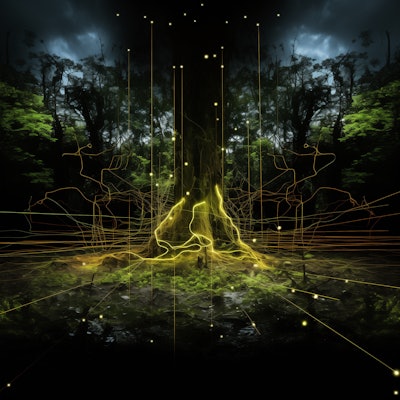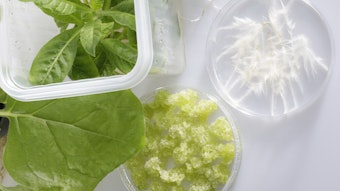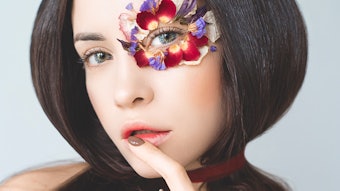
Plants hold a beauty secret.
Each of the at least 350,000 species found on Earth symbiotically hosts anywhere from two to even hundreds of endophyte organisms that comprise their inter- and intracellular microbiota.
These endophytes produce bioactive secondary metabolites that are similar or even identical to those produced by their host plants and which help botanicals to withstand biotic and abiotic stresses.
These same stressor-fighting materials have benefits as cosmetic actives for human skin, uniting the kingdoms of plants, microbiota and animals.
Most of these powerful endophytes have yet to be discovered, much less scaled up for application in beauty. Provital is changing that.
"Beneficial endophytes produce a large number of compounds that are useful across many sectors, including agriculture, medicine, food and, now, cosmetics," says David Manzano, research and innovation manager, Provital. "They can synthesize metabolites belonging to all major classes of natural compounds, including isoprenoids, alkaloids and polyphenols. Additionally, they can synthesize other interesting molecules with important industrial applications, such as phytohormones, pigments and enzymes. For example, their application in the agricultural industry as sustainable biostimulants and biopesticides is blooming."
Manzano adds, "Endophytes have long been recognized as a source of anticancer agents, ever since the discovery that an endophytic fungus obtained from Pacific Yew bark (Taxus brevifolia), was able to produce the valuable drug Taxol. Since then, many other anticancer compounds, as well as compounds possessing antimicrobial, antioxidant, and anti-inflammatory properties, have been discovered to be synthesized by endophytes. Another notable example is the capacity of some endophytic strains isolated from grapes to produce resveratrol and other stilbenes."
He concludes, "Considering the abundance of plant endophytes and the fact that many of them are yet to be discovered, the potential of this metabolic reservoir is immense. We are pioneers in taking a systematic approach to harnessing the benefits of these natural micro-biofactories for the development of new and sustainable cosmetic active ingredients."
A New Generation of Beauty Bioactives
 The company’s Triplobiome™ technology and proprietary production process isolates relevant endophytic strains from plants, including yeast and bacteria, and screens them for bioactive components. The best candidates are then selected for scaled-up production via cutting-edge biotechnology.Provital
The company’s Triplobiome™ technology and proprietary production process isolates relevant endophytic strains from plants, including yeast and bacteria, and screens them for bioactive components. The best candidates are then selected for scaled-up production via cutting-edge biotechnology.Provital
The result is a growing palette of natural, sustainable and highly effective biofermented beauty actives, powering new product claims while fulfilling consumers’ desires for cleaner, greener formulations.
"We have successfully developed a novel platform for the isolation and biotechnological production of plant endophytes," says Manzano. "Our current collection comprises hundreds of strains isolated from various Mediterranean and medicinal plants."
He continues, "Plant endophytes exhibit a range of beneficial activities for plants, aiding in their ability to withstand stresses such as pathogen attacks, herbivore feeding, nutrient deficiencies, drought and excess UV radiation, among others. We are leveraging these benefits derived from the symbiotic relationship between plants and their endophytes to enhance skin care, offering applications such as barrier protection, hydration, anti-aging and anti-pollution effects."
Manzano adds, "Through our platform, we conduct initial screenings of isolated endophytic strains, followed by bioprocess optimization of selected strains. This results in a diverse array of potential active ingredients for skin and hair care, applicable across a wide range of cosmetic formulations. Our process is meticulously traceable and sustainable. By avoiding the need for vast amounts of land and plant biomass, we offer a viable alternative for producing cosmetic actives while mitigating the overexploitation of host plants."
A Powerful Well-ager from the Cork Microbiome
 Provital’s Shiloxome™ The active was derived from Kwoniella mangroviensis yeast extracted from the bark of the cork oak (Quercus suber), which is well-known for its centuries-long lifespan. The extraction causes no harm to the host plant, ensuring maximum sustainability.Provital
Provital’s Shiloxome™ The active was derived from Kwoniella mangroviensis yeast extracted from the bark of the cork oak (Quercus suber), which is well-known for its centuries-long lifespan. The extraction causes no harm to the host plant, ensuring maximum sustainability.Provital
The active was derived from Kwoniella mangroviensis yeast extracted from the bark of the cork oak (Quercus suber), which is well-known for its centuries-long lifespan. The extraction causes no harm to the host plant, ensuring maximum sustainability.
The yeast, which supports the health of the tree’s protective bark, is a key element in its insulation from the elements.
By scaling up the strain’s bioactive phytochemicals, Provital has been able to infuse Shiloxome™ with well-aging and anti-pollution benefits, as well as restructuring properties for the skin’s protective barrier.
In effect, Provital has successfully emulated the source botanical’s ecosystem for multi-benefit skin protection.
“We have demonstrated the efficacy of Shiloxome as a well-aging and anti-pollution active both in vitro and in vivo through a multi-omic study,” says Manzano. “In vitro, the active protects keratinocytes from damage caused by pollution, reversing the production of reactive oxygen species (ROS) and inflammatory markers induced by urban dust. Additionally, transcriptomics analysis conducted on fibroblasts demonstrates the positive impact of Shiloxome on their extracellular matrix. This is further validated at the protein level through quantification of collagen and elastin levels, providing well-aging effects.”
Manzano adds, “In our clinical study, our cutting-edge and pioneering whole-lipidome analysis reveals the identification of hundreds of lipid metabolites regulated by Shiloxome. By meticulously studying these changes, we have observed an increase in the chain lengths of lipids, particularly ceramides. Importantly, long-chain ceramides are associated with a robust barrier function. Furthermore, the lipidomic analysis demonstrates that Shiloxome prevents lipid oxidation across different lipid classes, including triglycerides and squalene.”
He concludes, “Additionally, microbiome analysis reveals that the active does not alter the natural diversity of the skin microbiome, which serves as the first natural barrier of the skin. These protective and well-aging effects are further confirmed by analysis of skin instrumental parameters, which show improvements in brightness, transepidermal water loss (TEWL), tone evenness, smoothness, and elasticity of the skin. Notably, these results are particularly enhanced when considering women in the post-menopausal stage.”
Validating Multi-“omic” Efficacy
 Provital’s Shiloxome™ offers benefits across three “omics”—exposomics (microbiome diversity), transcriptomics (well-aging) and lipidomics (barrier care).Provital
Provital’s Shiloxome™ offers benefits across three “omics”—exposomics (microbiome diversity), transcriptomics (well-aging) and lipidomics (barrier care).Provital
- Lipidomics—which examines the pathways and networks of cellular lipids in biological systems—was used to evaluate how Shiloxome™ enhanced an impressive number of ceramides and triglycerides and how that enhancement improves the packing and organization of lipids to support barrier function in polluted environments. The technology accomplishes this by modulating the skin’s whole lipidome profile toward lipids with longer carbon chains.
- Transcriptomics—the study of all of an organism’s RNA transcripts—show the capacity of Shiloxome™ to induce the formation of extracellular matrix in human dermal fibroblasts; this was also demonstrated at protein level, indicating well-aging benefits.
- Exposomics was used to evaluate the preservation of the skin’s microbial diversity when subjected to the new ingredient, a key aspect to prevent skin from ROS damage coming from pollution.
“One of the most significant advancements in molecular biology in recent years involves the use of omics techniques, which analyze the entire genome, transcriptome, proteome, and even metabolome of tissues and cells,” says Manzano. “These studies generate vast amounts of data, and bioinformatic pipelines are employed to compare samples and identify the most significant differences resulting from treatments."
He adds, "The technological developments associated with these techniques have been impressive, leading to a reduction in costs and making them available even for routine experiments, especially for genomics and transcriptomics data. At Provital, we have fully embraced the use of these omics techniques at all the aforementioned levels, and we have our own bioinformatics expertise to handle this complex analysis. The result is the development of actives whose efficacy is supported by cutting-edge technologies, enabling us to gain deeper insights into their mechanisms of action.”
Sustainable & Science-forward
Provital’s Triplobiome™ Technology is just one example of how the company puts its “Do Care” ethos into action, originating 100% traceable, sustainable and effective ingredients to the market.
As Nina Esposito, Provital’s area sales and marketing director, puts it, “Just as the world operates as a large, interconnected big data network, so does the complex fabric of an ecosystem. In our world, various interkingdom symbiotic relationships are essential for the balance and vitality of the entire system.”
To learn more about Shiloxome™, the Triplobiome™ platform and Provital’s innovation agenda, visit www.weareprovital.com/en/be-tech/biotechnological-products/triplobiometm-technology
Disclaimer:
The above paid-for content was produced by and posted on behalf of the Sponsor. Content provided is generated solely by the Sponsor or its affiliates, and it is the Sponsor’s responsibility for the accuracy, completeness and validity of all information included. Global Cosmetic Industry takes steps to ensure that you will not confuse sponsored content with content produced by Global Cosmetic Industry and governed by its editorial policy.










